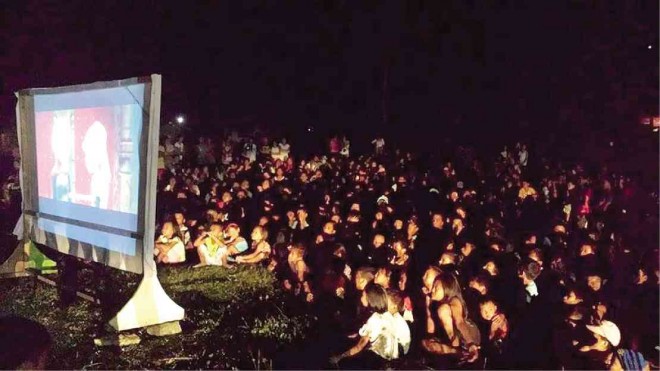
COPING WITH STRESS A film showing is held at California Village in Barangay Tuburan in Albay province’s Ligao City as part of psychosocial activities to remove the stress and anxiety of thousands of people who were evacuated from their homes after Alert Level 3 was hoisted over Mayon Volcano. MICHAEL B. JAUCIAN/INQUIRER SOUTHERN LUZON
LEGAZPI CITY—Classes will resume today in donated tents for over 50,000 students whose schools are being used as evacuation centers in the face of the possible eruption of Mayon Volcano in Albay province.
The provincial government received 155 tents from the United Nations Children’s Fund (Unicef), which served as classrooms after the Philippine Institute of Volcanology and Seismology (Phivolcs) raised alert level 3 over Mayon on Sept. 15.
Classes have been suspended in 38 schools now being used as temporary shelters and those within the 6-kilometer radius permanent danger zone, affecting a total of 51,634 students. The figure includes 14,710 student evacuees, Assistant Education Secretary Reynaldo Laguda told the Inquirer.
The Unicef tents arrived over the weekend for distribution to the evacuation centers. On Saturday, the Army’s 2nd Infantry Battalion put up five tents with a floor area of 54 square meters and 10 tents with an area of 42-sq m in Guinobatan town. They delivered 10 42-sq m tents to Camalig town.
Laguda said 542 classrooms were being used as evacuation shelters but the tents numbered only 155. He said students, especially those in the elementary grades, would be grouped to morning and afternoon shifts so that classes could resume immediately.
Teachers in the affected areas would conduct the emergency classes, he added.
Regional Director Ramon Fiel Abcede of the Department of Education in Bicol said in a text message that despite the lack of facilities, especially armchairs, classes would resume on Tuesday.
Some students could sit on the floor while others could take other chairs not being used by the evacuees, Abcede said.
At Guinobatan West Central School, classes resumed on Monday, with around 200 pupils crowding one room. Evacuees from Barangay (village) Doña Tomasa were occupying the other rooms.
The school principal, Eden Cardoso, said Grades 1 to 3 pupils would use the rooms in the morning while those in Grades 4 to 6 would use them in the afternoon.
Crisencia Oro, a Grade 3 teacher, said the children could not focus on their lessons but a colleague, Misalina Rontas, said the setup was better than leaving the children at home doing nothing.
Rontas said she expected the situation to ease up when the tents are put up.
Albay Gov. Joey Salceda said 1,025 classroom-tents, 55,000 chairs and 57 comfort rooms were still needed.
At Camalig North Central School, a medical team of the Armed Forces of the Philippines Southern Luzon Command based in Camp Nakar in Lucena City came to provide medical services to the evacuees.
A military doctor, Capt. Donne Framil, said most of the children were suffering from cough, flu, fever and other ailments, while the elderly were experiencing high blood pressure due to extreme heat and poor ventilation.
“Rashes and eczema are also prominent,” he said.
Cecil Marquez said her 8-month-old baby girl could not sleep at night and was crying most of the time because of difficulty in breathing. “I am very happy that military doctors and nurses are here to conduct medical checkups,” she said.
In Ligao, the city government conducted on Sunday psychosocial activities for thousands of evacuees who have been staying at National Housing Authority units in Barangay Tuburan for nearly a week. They were treated to parlor games, enlivened by the presence of mascot Dora the Explorer, and enjoyed a three-hour film showing.
Phivolcs said the possibility of Mayon’s eruption remained despite a slowdown in activity. On Monday, three volcanic earthquakes and 13 rockfall occurrences were recorded, compared with Sunday’s four volcanic earthquakes and eight rockfall events.
Eduardo Laguerta, Phivolcs resident volcanologist based in this city, had earlier stressed that the decrease in activity could mean that the rise of magma has stopped temporarily. Mayon might just be preparing for a possible eruption as pressure inside increases, he said.